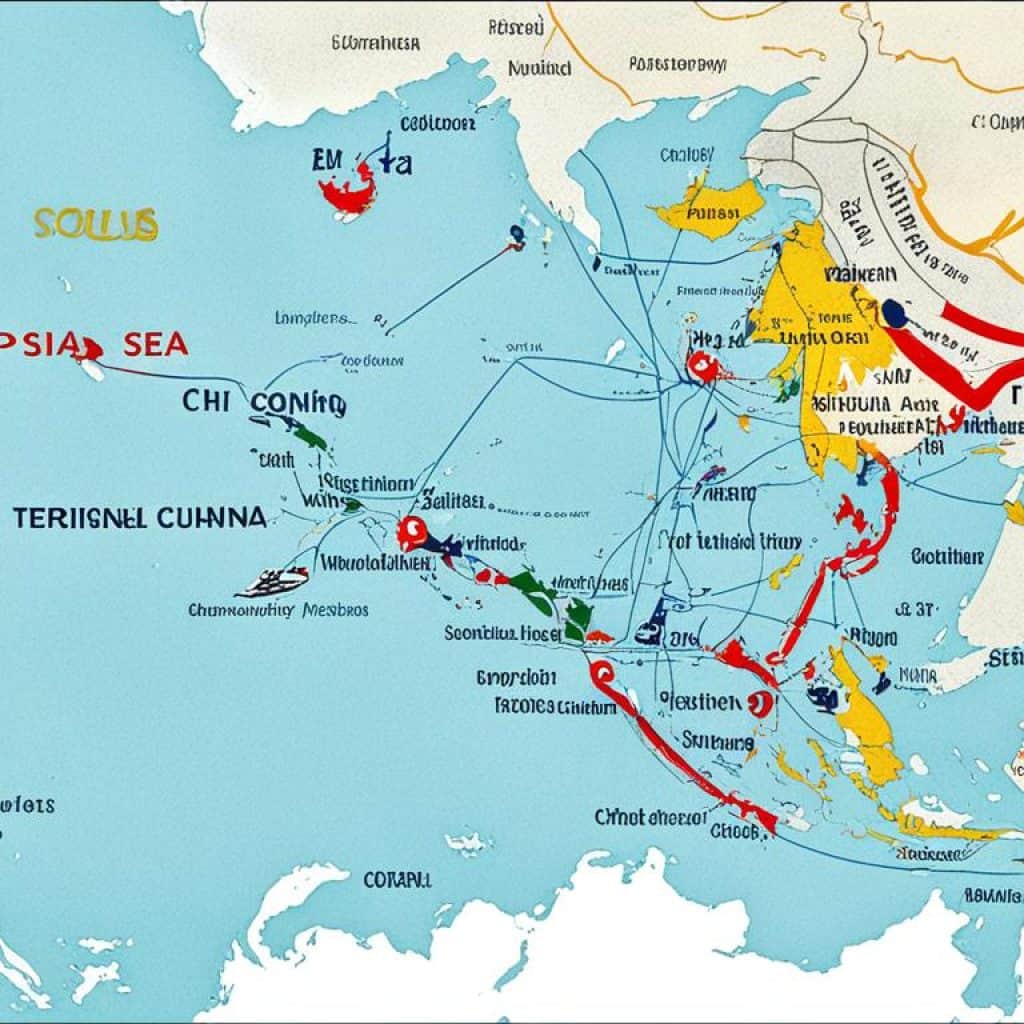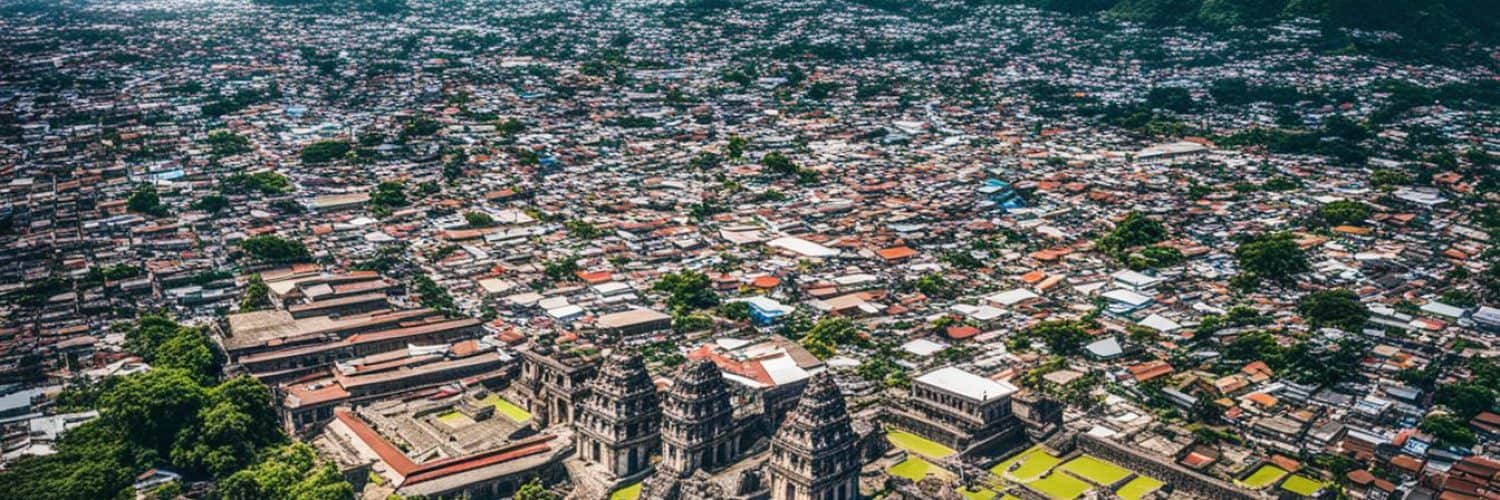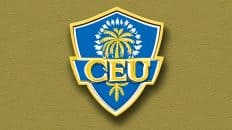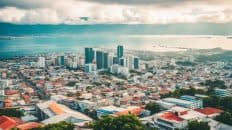Did you know that the history of the Philippines dates back to the earliest human activity more than 700,000 years ago? This archipelago has been home to various ethnic groups and witnessed the rise and fall of ancient states influenced by Islamic, Indian, and Chinese cultures. But what is the oldest city in the Philippines? And what secrets does it hold?
In this article, we will explore the fascinating history of the Philippines and uncover the secrets of its oldest city. From the precolonial period to the Spanish and American colonial eras, we will delve into the historical events and influences that have shaped the nation’s heritage. Join us on this journey through time and discover the hidden stories of the oldest Philippine city.
Key Takeaways:
- The history of the Philippines dates back over 700,000 years.
- Various ethnic and social groups have inhabited the archipelago throughout history.
- The oldest city in the Philippines holds secrets waiting to be revealed.
- Islamic, Indian, and Chinese cultures have influenced the development of ancient states.
- Exploring the history of the Philippines provides a deeper understanding of its rich heritage.
Prehistoric Period (pre-900)
The prehistoric period in the Philippines is a fascinating chapter in the country’s history that dates back to before 900. This era provides a glimpse into the early human activity that took place in the archipelago, setting the stage for the development of the vibrant culture and society that exists today.
During this time, there is evidence of early hominin activity in the Philippines, with the presence of Homo luzonensis on the island of Luzon at least 134,000 years ago. This archaic human species adds to our understanding of the diversity of humans that once roamed the region.
One of the remarkable discoveries from this period is the Tabon Man, found in the province of Palawan. These skeletal remains provide valuable insights into the lives of early inhabitants and their physical characteristics. The Tabon Man is a testament to the rich prehistoric heritage of the Philippines.
Another significant development during this period is the Austronesian expansion, which saw seafaring Austronesian people migrate southward from Taiwan. These early settlers brought with them their language, culture, and advanced seafaring skills, shaping the archipelago’s cultural landscape.
“The prehistoric period in the Philippines unveils the beginnings of human activity in the region, with Homo luzonensis, the Tabon Man, and the Austronesian expansion being vital pieces of this historical puzzle.”
Discoveries from the Prehistoric Period
The prehistoric period in the Philippines has yielded remarkable discoveries that shed light on the country’s ancient past. The presence of Homo luzonensis on the island of Luzon challenges our understanding of human evolution and migration patterns. The Tabon Man showcases the biological diversity of early inhabitants, while the Austronesian expansion highlights the early maritime exploration and contact between different cultures.
An image depicting the skeletal remains of the Tabon Man can be seen below:
These discoveries serve as a testament to the rich history of the Philippines, providing valuable insights into the origins of its people and the early development of its civilization.
Key Points:
- The prehistoric period in the Philippines predates 900.
- Homo luzonensis and the Tabon Man offer insights into early human activity.
- The Austronesian expansion brought seafaring peoples to the region.
- Discoveries from this period contribute to our understanding of the country’s ancient past.
Precolonial Period (900-1565)
The precolonial period in the Philippines, spanning from 900 to 1565, was a time of significant development and cultural exchange. During this era, historically documented states and polities emerged, leaving behind a valuable legacy for future generations to explore and learn from.
Among the notable states of this period were Caboloan, Tondo, Maynila, and Ma-i, among others. These states were characterized by complex social structures, advanced governance systems, and thriving economies.
One of the key factors that influenced the precolonial Philippines was its participation in the maritime Silk Road. This vast network of trade routes connected the Philippines with distant lands, facilitating the exchange of goods, ideas, and cultures. Indian and Chinese influences played a significant role in shaping the precolonial Philippine society.
A noteworthy symbol of the maritime trade during this period was the Balangay, a traditional boat used by indigenous peoples for long-distance voyages and maritime trade. These sturdy and efficient vessels allowed the Filipinos to navigate the vast oceans and establish trade links with neighboring countries.
“The precolonial period in the Philippines was characterized by the emergence of powerful states, intricate trade networks, and cultural interactions with Indian and Chinese civilizations.”
The maritime Silk Road brought with it Indian and Chinese influences in various aspects of Philippine culture, including art, language, religion, and cuisine. These influences can still be observed today and reflect the enduring legacy of this period.
In summary, the precolonial period in the Philippines marked a dynamic era of historically documented states, vibrant maritime trade, and Indian and Chinese influences. It is a crucial chapter in Philippine history that has shaped the nation’s identity and heritage.
Spanish Colonial Period (1565-1898)
The Spanish colonial period in the Philippines began with the arrival of Miguel López de Legazpi in 1565. After colonizing the archipelago, the Philippines became part of the Spanish East Indies and remained under Spanish rule for over 300 years. This period had a lasting impact on the country’s history, culture, and identity.
One significant aspect of the Spanish colonial period was the establishment of the Manila galleon trade. This trade route connected the Philippines with Mexico and other Spanish colonies, fostering economic growth and cultural exchange. The galleons transported valuable commodities like silk, spices, and porcelain, while also facilitating the flow of ideas, language, and traditions.
“The Manila galleon trade played a vital role in the region’s economy, contributing to the growth of Manila as a major trading hub and attracting merchants from around the world.”
Under Spanish rule, the Philippines experienced the introduction of Christianity, which became a dominant religion in the country. Spanish missionaries played a significant role in spreading the Catholic faith and establishing churches, leaving a lasting legacy in Philippine religious and cultural practices.
The Spanish administration also brought changes to the political and social systems in the Philippines. The archipelago was divided into administrative units called “cabildos,” with Manila serving as the capital. Spanish laws and governance structures were implemented, shaping the country’s legal and administrative framework.
Spanish influence extended beyond religion and administration. The Spanish language left a linguistic impact, influencing the development of the Filipino language and adding Spanish loanwords to the vocabulary. A mestizo culture emerged, blending Spanish and Filipino customs, traditions, and cuisine.
Image:

The Spanish colonial period also witnessed cultural assimilation, as the indigenous population adopted Spanish customs and practices. However, this blending of cultures was not without resistance and conflicts, as evidenced by numerous uprisings and revolts against Spanish rule.
| Key Aspects | Summary |
|---|---|
| Arrival of Miguel López de Legazpi | Miguel López de Legazpi’s arrival marked the beginning of Spanish colonization in the Philippines. |
| Manila Galleon Trade | The trade route between Manila and Mexico facilitated economic growth and cultural exchange. |
| Introduction of Christianity | Spanish missionaries spread Christianity and established churches, leaving a lasting religious impact. |
| Spanish Administration | Spanish laws, governance structures, and administrative units shaped the country’s political and social systems. |
| Cultural Assimilation | The blending of Spanish and indigenous cultures led to the emergence of a distinct mestizo culture. |
Impact on the Philippines
The Spanish colonial period significantly influenced the Philippines, leaving behind a legacy of religion, language, administration, and cultural assimilation. The country’s history during this period is marked by both cooperation and resistance, shaping the identity and resilience of the Filipino people.
American Colonial Period (1898-1946)
The American colonial period in the Philippines marked a significant shift in the country’s history. Following the Spanish-American War in 1898, the Philippines became a territory of the United States, bringing about a period of transition from Spanish to American rule.
The transition, however, was not without its challenges. The Philippine-American War erupted as Filipinos fought for their independence from foreign control. The war lasted from 1899 to 1902 and resulted in the loss of many lives on both sides.
“The fight for our independence was a long and arduous one, but it demonstrated the resilience and determination of the Filipino people.” – Emilio Aguinaldo, First President of the Philippines
Despite the resistance, the United States maintained control over the Philippines through the Treaty of Paris in 1898. The treaty effectively ended the Spanish colonial era and transferred sovereignty to the United States.
The Philippine Commonwealth and the Road to Independence
In 1935, the Philippine Commonwealth was established, granting the country a greater degree of self-governance under American supervision. This period laid the foundation for the eventual full independence of the Philippines.
The road to independence was further paved with the establishment of a Philippine government, led by President Manuel L. Quezon and Sergio Osmena as vice president. This government functioned as an interim administration, preparing the country for self-rule.
On July 4, 1946, the Philippines finally gained independence from the United States, becoming the first country in Southeast Asia to do so. This marked an important milestone in Filipino history and a significant achievement for the Filipino people.
The Legacy of the American Colonial Period
The American colonial period left a lasting impact on the Philippines. It brought about significant changes in governance, education, healthcare, and infrastructure. The United States introduced modern bureaucratic systems, established a comprehensive public education system, and improved healthcare services throughout the archipelago.
However, the period was not without controversy. Some argue that American colonial rule also resulted in economic exploitation, cultural assimilation, and the erosion of indigenous traditions and languages.
| Key Events | Years |
|---|---|
| Philippine-American War | 1899-1902 |
| Treaty of Paris | 1898 |
| Establishment of the Philippine Commonwealth | 1935 |
| Philippine Independence | 1946 |
The image above captures a glimpse of daily life during the American colonial period in the Philippines. It serves as a visual reminder of the historical significance of this era and the challenges faced by the Filipino people.
Despite the complexities and contradictions of the American colonial period, it remains an important chapter in the Philippines’ journey towards independence and self-determination.
Japanese Occupation and World War II (1941-1945)
During World War II, the Philippines faced a challenging period as it was occupied by Japan from 1941 to 1945. The Japanese occupation brought significant changes and hardships to the country, leaving a lasting impact on its history.
The occupation began on December 8, 1941, just hours after the attack on Pearl Harbor. Japanese forces quickly overwhelmed American and Filipino defenses and took control of the Philippines. The country became a strategic stronghold for Japan in Southeast Asia.
The Battle of Bataan, which took place from January to April 1942, marked a crucial moment in the Japanese occupation. American and Filipino soldiers fought bravely but were eventually forced to surrender due to lack of supplies and reinforcements. The surrender led to the infamous Bataan Death March, during which thousands of Filipino and American prisoners of war were subjected to brutal treatment.
| Battle | Date | Significance |
|---|---|---|
| Battle of Bataan | January-April 1942 | Forced surrender of American and Filipino forces; Bataan Death March |
| Battle of Corregidor | May 1942 | Japanese victory; complete occupation of the Philippines |
Another significant battle was the Battle of Corregidor in May 1942, where the Japanese forces successfully captured the island. The fall of Corregidor marked the complete occupation of the Philippines by Japan.
In the midst of the occupation, the Philippines saw a strong resistance movement. Filipino guerrilla fighters, supported by American forces, carried out acts of sabotage and engaged in guerrilla warfare against the Japanese occupiers. The resistance movement played a vital role in undermining Japanese control and gathering intelligence for the Allied forces.
The liberation of the Philippines began in 1944, as Allied forces launched a series of military campaigns to retake the islands. The Battle of Leyte Gulf, considered one of the largest naval battles in history, was a turning point in the liberation. Filipino and American forces successfully repelled the Japanese navy, weakening Japan’s hold on the region.
The Allied forces continued their advance, and on October 20, 1944, General Douglas MacArthur famously returned to the Philippines, fulfilling his promise to return. The combined efforts of Filipino, American, and Allied forces led to the eventual liberation of the Philippines from Japanese occupation.
The Japanese occupation and World War II had a profound impact on the Philippines. The country faced immense suffering and destruction, with countless lives lost and infrastructure damaged. However, the resilience of the Filipino people and the strong resistance movement laid the foundation for the eventual liberation and rebuilding of the nation.
Post-Independence Period (1946-Present)
After gaining independence from the United States in 1946, the Philippines entered a new era. The country underwent significant political changes, shaping its journey into the contemporary period. One notable milestone was the establishment of the Third Republic, marking a new phase in Philippine governance.
However, it was the People Power Revolution in 1986 that captured the world’s attention. This peaceful uprising, also known as the EDSA Revolution, witnessed the Filipino people collectively voicing their desire for democratic change. Millions of Filipinos gathered in the streets of Manila to call for electoral reform, ultimately leading to the ousting of President Ferdinand Marcos and the restoration of democracy. The People Power Revolution stands as a testament to the power of collective action, inspiring similar movements worldwide.
In the contemporary period, the Philippines faced numerous challenges, including economic crises and territorial disputes. Despite these obstacles, remarkable progress has been made in areas such as democracy and human rights. The country has witnessed significant strides towards ensuring the well-being and empowerment of its citizens.
The Philippines continues to evolve and adapt, navigating the complexities of a dynamic global landscape. It remains a vibrant nation with a rich cultural heritage and a diverse population. As the country forges ahead, it embraces its role in shaping a brighter future for its people and the international community at large.
Key Takeaways:
- The post-independence period in the Philippines began in 1946 after gaining independence from the United States.
- The establishment of the Third Republic and the People Power Revolution were crucial political milestones during this period.
- The People Power Revolution showcased the power of collective action and led to the restoration of democracy.
- The contemporary period has been marked by challenges, including economic crises and territorial disputes.
- Significant progress has been made in areas such as democracy and human rights.
Ancient Religions and Cultural Achievements
The cultural heritage of the Philippines is deeply interwoven with its ancient religions and indigenous beliefs, resulting in a rich tapestry of artistic and literary achievements. These cultural expressions remain as valuable testaments to the diverse and vibrant history of the Filipino people.
One of the pillars of Philippine culture is its ancient religions, which were shaped by a blend of influences. Indigenous beliefs and practices formed the foundation of these religions, with reverence for nature, ancestral spirits, and deities. This connection to the spiritual world was further enriched by Hindu-Buddhist influences brought by traders and missionaries from neighboring Southeast Asian kingdoms.
Later in Philippine history, Islam and Christianity arrived in the archipelago, leaving their mark on the religious landscape. Islamic beliefs were introduced through trade and cultural exchanges with Muslim merchants, while Christianity took root during the Spanish colonial period, ultimately becoming the dominant religion of the Philippines.
Philippine art and literature played a significant role in preserving and communicating these religious traditions. Through sculpture, painting, and textiles, artists depicted mythological figures, gods, and goddesses, as well as scenes from religious rituals. The use of symbols, patterns, and colors bridged the gap between the spiritual and physical realms, conveying profound meanings and emotions.
One remarkable example of ancient Philippine art is the Angono Petroglyphs, located in Rizal province. These rock carvings, believed to be at least 5,000 years old, depict various animals, human figures, and geometric designs. They provide a window into the prehistoric spiritual beliefs and cultural practices of the early inhabitants of the Philippines.
“The ancient religions of the Philippines were deeply intertwined with the cultural fabric of the Filipino people. Through art and literature, they conveyed their spiritual beliefs, paying homage to the gods and ancestors who shaped their lives.”
Another outstanding cultural achievement is the Baybayin script, an ancient writing system used by early Filipinos before the arrival of the Spanish. The script, composed of characters with curvilinear lines, was primarily used to transcribe religious and cultural texts, reflecting the importance of written communication in preserving traditions and sharing knowledge.
In addition, the golden Tara of Agusan stands as a testament to the Philippines’ lavish artistic heritage. This ornate gold statue, discovered in 1917 in Butuan City, depicts a female figure adorned with intricate jewelry and regalia. Believed to represent a Hindu-Buddhist deity or an indigenous goddess, the golden Tara showcases the fusion of religious beliefs and cultural aesthetics during the ancient period.
The enduring legacy of ancient religions and cultural achievements in the Philippines serves as a testament to the resilience and creativity of its people. These cultural treasures provide a glimpse into the spiritual and artistic depths that continue to shape the Filipino identity to this day.
Historical Cities and Landmarks
The Philippines is a country with a rich historical past, and it is home to numerous cities and landmarks that are a testament to its vibrant history and diverse culture. These historical cities and landmarks give us a glimpse into the different periods of the country’s development, from the Spanish colonial era to precolonial settlements. They serve as living reminders of the Philippines’ journey through time.
One of the most iconic historical cities in the Philippines is Intramuros, located in the heart of Manila. Intramuros, which translates to “within the walls” in Spanish, was built by the Spaniards during the colonial period. It is a walled city that served as the seat of political, military, and religious power. Today, Intramuros stands as a popular tourist destination, offering visitors a chance to explore its cobblestone streets, ancient churches, and well-preserved colonial architecture. Walking through its storied walls, you can almost feel the echoes of the past and imagine the lives of the people who once inhabited this vibrant city.
Vigan, another gem of Filipino heritage, is a Spanish colonial town located in Ilocos Sur. Recognized as a UNESCO World Heritage Site, Vigan is renowned for its well-preserved ancestral houses, quaint streets, and horse-drawn carriages. Stepping into Vigan feels like stepping back in time, as the town’s architecture and layout have remained largely unchanged for centuries. Exploring Vigan’s narrow streets, lined with heritage houses, is like experiencing a living museum of Spanish colonial architecture and a testament to the enduring heritage of the Philippines.
The Beauty of Heritage Houses
One of the distinct features of the Philippines’ historical cities and landmarks is the presence of heritage houses. These houses serve as tangible links to the past and showcase the architectural styles and influences from different periods in history. The Philippines boasts numerous heritage houses, each with its unique story and charm.
“These heritage houses stand as silent witnesses to the Philippines’ rich history, and they offer visitors a glimpse into the lives of the people who inhabited them.” – Philippine Heritage Preservation Society
These houses come in various architectural styles, ranging from Bahay na Bato (house of stone), characterized by its mix of Filipino, Spanish, and Chinese influences, to traditional wooden bahay kubo (nipa hut) designs. Many of these heritage houses have been transformed into museums, galleries, restaurants, or boutique hotels, allowing visitors to experience the grandeur of the past.
| Historical City or Landmark | Location | Key Features |
|---|---|---|
| Intramuros | Manila | Walled city, ancient churches, colonial architecture |
| Vigan | Ilocos Sur | Spanish colonial town, ancestral houses, horse-drawn carriages |
| Taal Heritage Town | Batangas | Well-preserved ancestral houses, religious structures |
| Silay City | Negros Occidental | Art Deco mansions, sugar industry heritage |
Preserving Our Cultural Legacy
As guardians of these historical cities and landmarks, the Philippines takes pride in its efforts to preserve its cultural heritage. Government agencies, non-profit organizations, and local communities work hand in hand to ensure the conservation and restoration of these treasures.
- Restoration projects focus on repairing and reviving historical structures to maintain their authenticity.
- Cultural festivals and events celebrate the vibrant traditions and customs associated with these cities and landmarks.
- Educational programs and guided tours provide visitors with insights into the history and significance of these areas.
- Efforts are made to pass down knowledge and traditional skills related to the maintenance of heritage houses.
By valuing and taking care of these historical cities, landmarks, and heritage houses, the Philippines ensures that future generations can continue to appreciate and learn from their rich history and cultural legacy.
Territorial Disputes and Geopolitics
The Philippines has been involved in territorial disputes, particularly in the South China Sea, which it refers to as the West Philippine Sea. These disputes involve claims over islands, reefs, and waters in the region, such as the Spratly Islands and Scarborough Shoal. The Spratly Islands, also known as the Kalayaan Island Group, are a cluster of islands, islets, and features claimed by the Philippines, China, Taiwan, Vietnam, Malaysia, and Brunei. The Scarborough Shoal, also known as Bajo de Masinloc or Panatag Shoal, is another area of contention between the Philippines and China.
These territorial disputes have significant geopolitical implications. The South China Sea is a critical maritime region, with vast energy resources, strategic shipping routes, and important fishing grounds. The overlapping claims have led to tensions and conflicts among the countries involved, including the Philippines and China. The Philippines, recognizing the importance of upholding its sovereignty and protecting its maritime interests, has sought international arbitration to resolve the disputes.
Despite the complexities of geopolitics in the region, the Philippines has been proactive in engaging with its neighboring countries and international organizations to address these territorial disputes. Through diplomatic negotiations and legal avenues, the Philippines aims to assert its rights, promote peaceful resolutions, and ensure stability in the South China Sea.
International Arbitration and Its Implications
In 2016, the Philippines won a landmark case against China in an international arbitration tribunal constituted under the United Nations Convention on the Law of the Sea (UNCLOS). The tribunal invalidated China’s nine-dash line claim, which encroached on the Philippines’ exclusive economic zone and continental shelf. The ruling affirmed the Philippines’ rights over its maritime resources and clarified the legal basis for resolving maritime disputes.
“The arbitral tribunal’s award in the Philippines-China case provides an opportunity for all parties to maintain a rules-based maritime order and seek peaceful resolutions to territorial disputes.”
The international arbitration victory reinforced the Philippines’ position and bolstered its diplomatic efforts in asserting its sovereignty and maritime rights. It also highlighted the significance of international law in resolving territorial disputes and maintaining regional stability.

The Way Forward: Diplomacy and Cooperation
Resolving territorial disputes requires a delicate balance of diplomacy, cooperation, and adherence to international law. The Philippines recognizes the importance of dialogue and negotiation in finding mutually acceptable solutions. The country has actively pursued diplomatic channels, such as bilateral talks and multilateral platforms like the Association of Southeast Asian Nations (ASEAN), to engage with other claimant states and promote regional cooperation.
Seeking peaceful resolutions to territorial disputes is crucial for the stability and security of the region. It requires the commitment of all parties involved to uphold international law, respect each other’s rights, and promote mutual trust and understanding.
Summary of Territorial Disputes
| Disputed Area | Claimant Countries |
|---|---|
| Spratly Islands | China, Taiwan, Vietnam, Philippines, Malaysia, Brunei |
| Scarborough Shoal | China, Philippines |
Impact of Colonialism on Indigenous Cultures
The colonial periods in the Philippines had a profound and lasting impact on the indigenous cultures of the archipelago. The arrival of foreign powers brought significant changes, leading to cultural assimilation, forced labor, and land dispossession among indigenous communities. Despite these challenges, indigenous cultures have demonstrated remarkable resilience, striving to preserve their traditions, languages, and customs.
“Cultural assimilation, forced labor, and land dispossession were among the many hardships endured by indigenous communities during the colonial periods in the Philippines.”
Indigenous cultures in the Philippines have played a crucial role in shaping the country’s identity and diverse heritage. These cultures are deeply rooted in the land, reflecting a profound connection to ancestral territories and natural resources. The preservation of indigenous traditions is essential not only for the cultural well-being of these communities but also for the preservation of the country’s history and collective identity.
Efforts are being made to promote indigenous rights and protect their cultural heritage. Recognizing the importance of cultural preservation, initiatives have been implemented to document indigenous languages, revive traditional practices, and promote cultural exchange between indigenous communities and the wider Filipino society.
Preservation of Indigenous Traditions
The preservation of indigenous traditions is a multidimensional endeavor that encompasses various aspects of cultural heritage. It involves the revitalization of indigenous languages, the protection of sacred sites and traditional ecological knowledge, and the promotion of indigenous arts, crafts, and performances.
One example of successful cultural preservation is the establishment of cultural villages and centers that showcase indigenous traditions and provide platforms for indigenous communities to share their knowledge and practices. These centers serve as living museums, where visitors can learn about indigenous cultures, interact with community members, and appreciate the richness of their traditions.
Indigenous Rights and Advocacy
Advocacy for indigenous rights and the protection of indigenous cultures is an ongoing endeavor in the Philippines. Indigenous communities, along with civil society organizations and human rights advocates, work tirelessly to raise awareness about the challenges faced by indigenous peoples and the need to respect their rights.
Various legal mechanisms and policies have been enacted to safeguard the rights of indigenous communities. The Indigenous Peoples Rights Act (IPRA) of 1997, for example, recognizes the collective rights of indigenous peoples, including the right to their ancestral domains, self-governance, and the preservation of their cultural integrity.
Looking Towards the Future
As the Philippines continues to navigate a post-colonial era, the preservation and revitalization of indigenous cultures remain integral to fostering a society that embraces its diverse heritage. By valuing and promoting the voices and contributions of indigenous communities, the country can strive towards a more inclusive and culturally rich future.
Preserving indigenous traditions not only benefits indigenous communities themselves but also enhances the broader understanding and appreciation of the cultural wealth and diversity found within the Philippines.
| Challenges Faced by Indigenous Communities | Efforts for Cultural Preservation |
|---|---|
| Cultural assimilation | Revitalization of indigenous languages |
| Forced labor | Protection of sacred sites and traditional ecological knowledge |
| Land dispossession | Promotion of indigenous arts, crafts, and performances |
Economic Development and Challenges
The Philippines has made significant strides in economic development, experiencing growth across various sectors including agriculture, manufacturing, and services. However, the country still faces persistent challenges that hinder progress and prosperity.
One of the major challenges in the Philippines is poverty. Despite the economic growth, a considerable portion of the population continues to live below the poverty line, struggling to meet their basic needs. This issue requires concerted efforts from the government, private sector, and civil society to create meaningful interventions and reduce poverty levels.
Inequality is another pressing challenge that the Philippines grapples with. Economic growth has not always translated into equitable distribution of wealth and resources, leading to disparities in income and opportunities. Addressing inequality is crucial for promoting inclusive growth and ensuring that all segments of society benefit from the country’s economic development.
Underemployment is a significant issue as well. Many Filipinos have jobs that are insufficient in terms of income or matching their skills and aspirations. This mismatch between labor supply and demand poses a challenge to the country’s overall productivity and human capital development.
The Philippines has a vast number of overseas Filipino workers (OFWs) who contribute significantly to the country’s economy through remittances. However, dependence on remittances also presents a vulnerability, as economic fluctuations in host countries can impact the livelihoods of OFWs and their families back home.
To address these challenges, the Philippine government is implementing various strategies and programs. These include initiatives to promote inclusive economic growth, improve labor market conditions, and enhance social protection measures. Additionally, efforts are being made to attract investments, boost entrepreneurship, and create more job opportunities for the Filipino workforce.
By addressing the challenges in poverty, inequality, underemployment, and the welfare of overseas Filipino workers, the Philippines aims to achieve sustainable and inclusive economic development. Through these measures, the country can work towards creating a more prosperous and equitable society for all its citizens.
Conclusion
The history of the Philippines is a fascinating journey that spans from prehistoric times to the present day. This diverse archipelago has witnessed the rise and fall of empires, colonization, and struggles for independence. Through the centuries, the impact of colonialism, the preservation of cultural heritage, and economic challenges have shaped the Philippines into the vibrant nation it is today.
Understanding the rich history of the Philippines allows us to appreciate its diverse culture, traditions, and the remarkable resilience of its people. From the ancient religions and cultural achievements to the historical cities and landmarks, the Philippines is a treasure trove of heritage. Exploring ancient archaeological sites, such as the Tabon Caves, and walking through the historic streets of Intramuros in Manila, transport us back in time and help us connect with the past.
As we reflect on the key takeaways from the Philippines’ history, we learn valuable lessons about the importance of cultural preservation, the enduring spirit of independence, and the ongoing commitment to economic development. Despite the challenges faced, the Filipino people have persevered and thrived, leaving an indelible mark on the world.


















Add comment